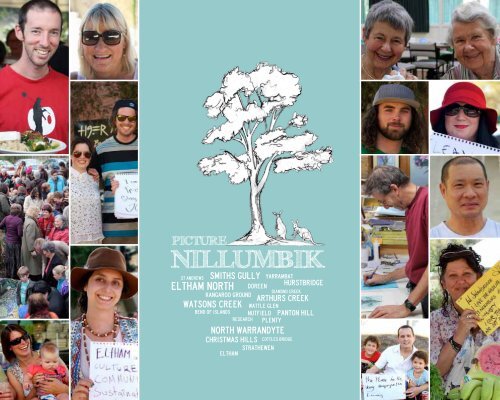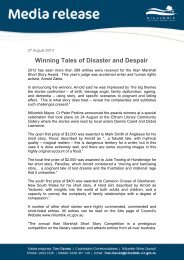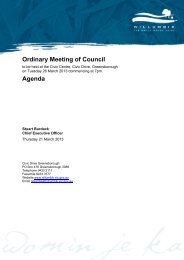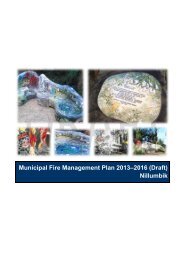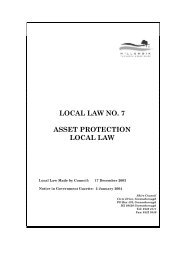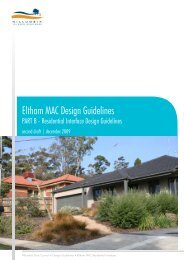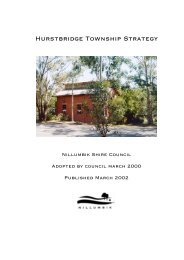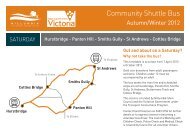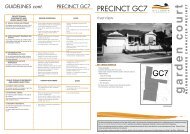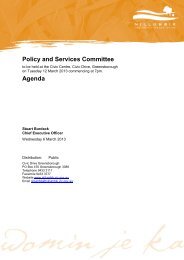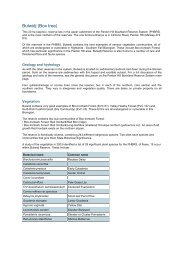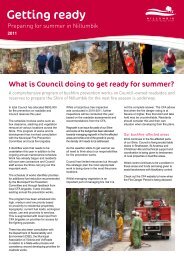Nillumbik Shire Council
Nillumbik Shire Council
Nillumbik Shire Council
Create successful ePaper yourself
Turn your PDF publications into a flip-book with our unique Google optimized e-Paper software.
PICTURE<br />
NILLUMBIK<br />
St Andrews<br />
Eltham North<br />
Smiths Gully<br />
Doreen<br />
Kangaroo Ground<br />
Watsons Creek<br />
Bend of Islands<br />
Research<br />
Wattle Glen<br />
North Warrandyte<br />
Christmas Hills<br />
Strathewen<br />
Eltham<br />
Yarrambat<br />
Hurstbridge<br />
Diamond Creek<br />
Arthurs Creek<br />
Nutfield Panton Hill<br />
Plenty<br />
Cottles Bridge
Picture <strong>Nillumbik</strong><br />
Picture <strong>Nillumbik</strong> is an on-going project and this publication is a prototype with limited circulation;<br />
it is currently considered as a work in progress. As a result, the quality of some of the images in this<br />
publication is not at the standard used for a formal <strong>Council</strong> publication.<br />
1
Preface<br />
Between October 2011 and June 2012, <strong>Nillumbik</strong> <strong>Shire</strong><br />
<strong>Council</strong> engaged Village Well to ask <strong>Nillumbik</strong> residents a<br />
seemingly simple question – ‘‘what is your vision for your local<br />
community’’ The range of responses and depth of feeling<br />
highlighted the diversity of people, passions and possibilities<br />
that make this <strong>Shire</strong> unique. Every community group, school<br />
and household was invited to identify what is important to them<br />
and their local area.<br />
This document represents a summary of more than 500<br />
responses, online submissions, interviews and workshop<br />
contributions. It also draws on extensive consultation previously<br />
undertaken by <strong>Council</strong>. Importantly, while this document does<br />
not include every submission, its words are shaped by every<br />
submission.<br />
The community values identified from this work are:<br />
• local village life – a love and affection for the unique<br />
township as a place to meet, shop, play and connect in a<br />
meaningful way<br />
• deep connection and resilient community – a community<br />
that comes together and responds to economic, social<br />
and environmental challenges<br />
• balance with nature – a community seeking to protect,<br />
nurture and experience the environment so that it can<br />
sustain life<br />
• a sustaining and evolving economy – local living, working<br />
and playing, creating the conditions for sustainable and<br />
economic growth in green business, sustainable transport,<br />
agriculture and food production<br />
• creative expression, art and cultural exchange – a community<br />
rich in cultural heritage worth sharing and celebrating<br />
• experience, discovery and fulfilment – lifelong learning,<br />
participatory democracy and positive living through all<br />
stages of life.<br />
Each chapter ends with a series of questions to encourage<br />
reflection and ongoing discussion. It is anticipated that this<br />
document will evolve with communities and as conversations<br />
continue, thus forming an important basis for future planning for<br />
both <strong>Council</strong> and the community.<br />
Ultimately, it is hoped that this document is inspiring, stimulating<br />
and a timely reminder that the future is worth planning for. To<br />
view this document online and continue the conversation visit<br />
www.nillumbik.vic.gov.au/picturenillumbik.<br />
Further Information<br />
If you require this document in an alternative format, please contact <strong>Nillumbik</strong> <strong>Shire</strong> <strong>Council</strong> on 9433 3111 or<br />
community@nillumbik.vic.gov.au. For further information visit www.nillumbik.vic.gov.au.<br />
1
Acknowledgements<br />
Special acknowledgement needs to be given to the Wurundjeri as the traditional custodians of the land now known as<br />
the <strong>Shire</strong> of <strong>Nillumbik</strong>. <strong>Nillumbik</strong> <strong>Shire</strong> <strong>Council</strong> values the significance of the Wurundjeri people’s history as<br />
essential to the unique character of the <strong>Shire</strong>.<br />
<strong>Nillumbik</strong> <strong>Shire</strong> <strong>Council</strong> also acknowledges the citizens, community groups and businesses from across the <strong>Shire</strong>, and the <strong>Council</strong><br />
staff and visitors of all ages who have contributed to this project. Thank you to everyone who participated in the project by<br />
submitting thoughts directly or giving private consideration to the issues raised.<br />
Special thanks go to the members of the Picture <strong>Nillumbik</strong> Advisory Group who were supporters and advocates for this project:<br />
Greg Thorpe<br />
Daryl Brooke<br />
Sarah Houseman<br />
Brigitte Kupfer<br />
Mal Harrop<br />
Ann Strutt<br />
Jess Richards<br />
Cr Ken King<br />
Chris Chapple<br />
2
COntents<br />
Chapter 1<br />
Deep Connection and<br />
Resilient Community<br />
05<br />
Chapter 2<br />
Local Village Life<br />
25<br />
Chapter 3<br />
Balance with Nature<br />
39<br />
Chapter 4<br />
A Sustaining and<br />
Evolving Economy<br />
53<br />
Chapter 5<br />
Creative Expression,<br />
Art and Cultural Exchange<br />
67<br />
Chapter 6<br />
Experience, Discovery<br />
and Fulfilment<br />
81<br />
Chapter 7<br />
Stewarding the<br />
<strong>Nillumbik</strong> Way<br />
99<br />
3
Visioning methodology<br />
1<br />
Desktop research<br />
2 3 4<br />
Resident surveys<br />
Project reference<br />
group<br />
<strong>Nillumbik</strong> news<br />
2000<br />
POSTCARDS<br />
DISTRIBUTED<br />
8<br />
Walk the beat (conversations<br />
with the community)<br />
7<br />
Place audit<br />
(12 towns)<br />
6<br />
Community<br />
publications<br />
5<br />
Online<br />
Presence<br />
NEWSLETTER<br />
NEWSPAPER<br />
9<br />
Formal<br />
engagement<br />
10 11<br />
<strong>Nillumbik</strong> values<br />
Draft community<br />
visioning publication<br />
12<br />
COMMUNITY<br />
PUBLICATION<br />
Creative expression, art and cultural exchange<br />
A Sustaining and Evolving Economy<br />
Local Village Life<br />
NEXT STEPS<br />
• Targeted sessions<br />
• Listening posts<br />
• Workshops<br />
• Interviews and individual profiles<br />
Deep connection and resilient community<br />
Balance with nature<br />
Experience, Discovery and Fulfillment<br />
4
Chapter 1<br />
Deep connection and<br />
resilient community<br />
Many people experience <strong>Nillumbik</strong> through social networks formed through local celebrations, sports, church<br />
groups, creative endeavours and projects.<br />
5
A connected community<br />
The connections people have with <strong>Nillumbik</strong> are revealed in<br />
their reverence for the landscape, shared memories, shared<br />
struggles and in their tendency to return time and again.<br />
This sense of connection is a powerful force, contributing to<br />
the strength of identity and the sense of belonging enjoyed by<br />
locals past and present.<br />
“(In <strong>Nillumbik</strong>) we have less concrete and a more ‘picturesque’ main street - more in line with the green wedge<br />
ideology. (I have) a sense of belonging and being part of a community that cares for all its components and achieves<br />
goals and milestones; pride in being part of a model community.”<br />
Eltham resident<br />
6
A community rich with hope and unity<br />
The resilience of a community centres on hope and the<br />
ability to respond to crises with strength and inner resolve.<br />
In <strong>Nillumbik</strong>, this has been clearly displayed since the 2009<br />
Black Saturday bushfires. With the land and community<br />
so damaged, it has forced people to find new meaning,<br />
relationships and identity.<br />
When the world went black<br />
When the world went black art brought colour to our world. Art was such an amazing healer. We all shared the same<br />
story and now we are getting a lot stronger.<br />
In Strathewen you know the names of your neighbours, so when a tragedy hits, it hits hard because you know so many people.<br />
Barbara Joyce<br />
12
Kite flyer<br />
A calm beyond the distant trees<br />
She takes the string and holds it tight<br />
Allows some slack into the breeze<br />
Keep watch the flyer of the kite<br />
When times are tough and life is bleak<br />
We do our best to make things right<br />
Take day by day and week by week<br />
Keep watch the flyer of the kite<br />
She willed the child forbade her to<br />
Go gently into this good night<br />
Strong fighting spirit shining through<br />
Keep watch the flyer of the kite<br />
A turning point the string breaks free<br />
The threat of danger losing sight<br />
With life there is no guarantee<br />
Keep watch the flyer of the kite<br />
Fee Sievers ©<br />
13<br />
Ona Henderson
case study<br />
Butterfly Studio<br />
Christmas Hills<br />
“We chose the butterfly as a feminine image that stands for rejuvenation and recovery. The butterfly is a<br />
gentle creature that floats in the wind and flits from home to home; the metaphor - a caterpillar that ate, grew<br />
and entered a cocoon to emerge as a thing of beauty”<br />
Sarah Hammond, Project Director<br />
Why is this initiative inspiring<br />
On 7 February 2009 a significant proportion of Christmas<br />
Hills was affected by the Black Saturday fires. A total of 18<br />
homes were lost while a further 20 homes were seriously<br />
damaged.<br />
The Butterfly Studio became a safe and nurturing space<br />
where people could meet, connect and learn new skills in<br />
a range of art media – an opportunity for people to come<br />
together with others to provide mutual support as part of<br />
the healing process.<br />
Since July 2010, over 180 people have participated in the<br />
program. The vision for the Butterfly Studio was to create<br />
a vibrant and viable community art studio. The program<br />
encourages donations of time and skills in exchange for<br />
workshop participation. The project also seeks to connect<br />
different community groups who may not normally work<br />
together and establish links with neighbouring communities.<br />
Studio activities since July 2010 include:<br />
• Memory Box Project (July 2010 – July 2011)<br />
• Felting Circle (May 2010 – ongoing)<br />
• painting workshops (November 2010 – August 2011)<br />
• Mosaic Gifting Project (October 2010 – ongoing)<br />
• drawing workshops (April 2011 – ongoing)<br />
• sculpture sessions (August 2010 – August 2011)<br />
• watercolour workshops (September – November 2011)<br />
14
case study<br />
The Tree project<br />
Strathewen<br />
“We were hoping to receive around 200 leaves, and now we have over 3000! We keep saying no more leaves, but they just keep coming!<br />
A member of the public suggested people sponsor a leaf to help raise money for the steel, copper and welding consumables to build the<br />
Tree. Over 1000 people have since sponsored leaves for the Tree, stamped with their name, the name of a loved one lost to the fires or a<br />
message of hope.”<br />
Amanda Gibson, Project Coordinator<br />
16<br />
Why is this initiative inspiring<br />
To honour the resilience of the communities affected by<br />
Black Saturday, the Australian Blacksmiths Association<br />
(Victoria) Inc. invited blacksmiths from all over Australia<br />
and the world to contribute to a memorial that would<br />
recognise the terrible loss but also celebrate healing,<br />
restoration and hope. The concept was born on an<br />
online blacksmiths’ forum seven days after the fires<br />
occurred and has now gathered contributions from<br />
20 countries in Europe, North America and the United<br />
Kingdom, and across Australia.<br />
Blacksmiths contributed gum leaves forged from<br />
stainless steel or copper to be assembled into an<br />
enormous forged tree. Amanda Gibson has carried this<br />
project close to her heart for three years, seeing it begin<br />
as a small endeavour that has grown beyond her wildest<br />
expectations.<br />
Blacksmiths trees are not unusual – there are many<br />
worldwide, a good portion of which have been<br />
instigated as forms of remembrance. For example, the<br />
Weeping Willow in Budapest was created to remember<br />
the tragedy of the Holocaust.<br />
Recently, The Tree Project has begun a partnership with<br />
blacksmiths in Norway, who are undertaking a steel<br />
rose sculpture in remembrance of the 2011 Norway<br />
massacre. This sister project sees roses exchanged for<br />
leaves for each sculpture, given by blacksmiths in these<br />
two almost polar opposite countries. Our global village<br />
becomes a much smaller place, connected by the<br />
universal human experience of tragedy and survival.
“What you have done so far and will eventually achieve<br />
is an amazing work of art and more importantly an<br />
emotional, deeply moving and beautiful memorial for<br />
all those affected by the bushfires…. What a legacy<br />
you are leaving! Well done.”<br />
Chris Crowe, Eltham resident<br />
“Strathewen has been totally decimated, but I am sure<br />
the tree will be a permanent symbol of remembrance<br />
of all the lives lost, homes destroyed and lives<br />
turned upside down. It will also be a symbol of hope,<br />
of future rebuilding and gradual repairing of the<br />
community.”<br />
Vicky Evans, Strathewen Resident<br />
“This tree is an amazing feat – it will be the biggest<br />
metal tree in the world and will display every realm of<br />
blacksmithing, from the industrial to the fine.”<br />
Amanda Gibson, Project Coordinator<br />
“This is so awesome and brings me so much<br />
comfort – the loss of my family has been<br />
crippling. The beauty and power of gestures<br />
like this project is that it provides the<br />
salve that helps me regain some mobility –<br />
otherwise called rebuilding one’s life. Thank<br />
you from the deepest place in my heart.”<br />
Rhonda Abotomy,<br />
Strathewen Resident<br />
“As we have seen from the recovery of the bushland in<br />
the fire affected areas the strength of Mother Nature<br />
is all around us. This tree is a reminder that there is<br />
17<br />
always HOPE. With hope there is a future for us all.”<br />
Jill McIver, Strathewen resident
case study<br />
Lasting memories mosaic group<br />
St Andrews<br />
“Amidst the devastation, bushfire affected women came together to share stories, laughter and tears. We have created this gift to<br />
the community as part of our healing. We honour the loss of life and the resilience of both people and nature and as our journey of<br />
recovery continues, we build hope for the future.”<br />
Collective Statement from the Lasting Memories Mosaic Group<br />
18<br />
Why is this initiative inspiring<br />
On 13 May 2012 (Mother’s Day), the Lasting Memories<br />
Mosaic Group gifted the mosaic seat to the community.<br />
The piece was unveiled before a crowd of local residents,<br />
friends and family in its new home in front of the St<br />
Andrews Hall. The seat is seven metres long and took<br />
20 women over two years to design and construct. It<br />
represents the journey and stories of the women involved<br />
and others affected by the Black Saturday fires.<br />
Chris Reade, Project Coordinator reflected:<br />
… personal stories, memories and experiences were<br />
bravely included into the mosaic design. We asked the<br />
St Andrews and surrounding fire affected communities to<br />
contribute one of their treasured broken remnants to be<br />
included on the seat.<br />
... at every stage we received help and support. What<br />
seemed like a daunting job was made easy by all the<br />
helping hands from this community and further afield.<br />
We felt like it was meant to be, somehow whatever we<br />
needed would come out of the woodwork. We would<br />
receive a call from someone saying I heard you need<br />
this, when can I drop it off<br />
Each week we helped each other through the turbulence<br />
of emotions … we were able to come together share<br />
experiences and make new and lasting connections<br />
within the community. It is not every day that you have<br />
the opportunity to feel connected with the community.<br />
We all feel that this was a genuinely special project to be<br />
a part of and gift to the community.<br />
The Lasting Memories Mosaic Group is continuing and is<br />
looking forward to creating more artworks. We are likely<br />
to see many more mosaic projects in the community.
“Working with this group of women on the mosaic<br />
seat has been a wonderful gift for me and I am forever<br />
grateful to them. It provided a comfortable space for<br />
us to share stories of loss and grief as well as to share<br />
some simple highlights like having a first hot bath or<br />
sleeping in a double bed.”<br />
Nan Oates, Panton Hill resident<br />
“Helping to decorate the mosaic seat was<br />
a great experience for me, meeting people<br />
who suffered the terrible fires and telling the<br />
stories. Finally laughing and eating pizzas –<br />
great for the soul and very fulfilling.”<br />
Norma Neil, St Andrews resident<br />
“Once a week, I escaped the life I had been forced<br />
into due to the fire and joined other bushfire affected<br />
women, creating mosaics from our own broken burnt<br />
pieces of treasures.”<br />
19<br />
Sonja Parkinson, St Andrews North
A place to age gracefully<br />
<strong>Nillumbik</strong> <strong>Shire</strong> is a place to enjoy growing older, with many<br />
opportunities to stay engaged, active and connected in the<br />
community, to volunteer time, learn new skills and teach<br />
younger generations.<br />
Community groups that enjoy high levels of participation<br />
include the University of the Third Age (U3A), Probus, senior<br />
citizens clubs, Rotary clubs, Lions clubs, Older Men: New<br />
Ideas (OM:NI), men’s sheds, Diamond Valley Miniature<br />
Railway and Eltham and District Woodworkers.<br />
However, the community continues to express a strong<br />
desire for facilities to improve wellbeing for all ages and<br />
abilities such as transport and mobility options, respite and<br />
accommodation, recreational activities such as a warm<br />
water therapy pool and a lawn bowls tournament.<br />
“I grew up here, got married here and came back. I am part of Eltham, I couldn’t settle in Thornbury I wanted to go back to<br />
my roots. The kids love it, they bring home lizards and are always in trouble.”<br />
“(We) can’t become extinct! We must replace the old person we are becoming with new people, we must help new families<br />
move in; families with local history already have to help their adult kids financially to stay in the area, if they are to raise<br />
their own families within the shire.”<br />
eltham resident<br />
20
case study<br />
Eltham & District Woodworkers Inc<br />
Yarrambat<br />
“It’s a pretty full house,” suggests members Barry McDonald, Barry Vaughan and Max Jenson.<br />
The Eltham & District Woodworkers Inc. has operated since<br />
1987 from the old school headmaster’s house in Yarrambat<br />
with hundreds of people visiting each weekend. There are<br />
about 95 members, and the house is open throughout<br />
the week to accommodate the variety of user groups:<br />
cabinet making, scroll sawing, woodturning, carving and<br />
pyrography.<br />
With all the tools and equipment in the house, the group has<br />
to hold their monthly meeting in the adjoining CFA brigade<br />
meeting rooms. In return for free access to this room, the<br />
group has built cabinets for the brigade.<br />
The membership comprises about two-thirds retirees, but a<br />
steady flow of new members maintains a mix of ages. Max<br />
Jenson added that ‘one of the great pluses is the skill within<br />
the community’. The group acquires donated materials from<br />
local sources: Barry McDonald reported that ‘there are a<br />
number of bower birds in [the] group’.<br />
In addition to public demonstrations, volunteers regularly<br />
work with seniors and people experiencing acquired brain<br />
injury.<br />
22
continue the<br />
conversation<br />
Questions for a resilient<br />
and connected future<br />
How can we ensure community connections help us meet the<br />
challenges of tomorrow<br />
How do we balance our desire for private sanctuary with our<br />
need for relationships<br />
How can we foster connections across all generations<br />
What does a truly inclusive community look like<br />
24
Chapter 2<br />
Local village life<br />
<strong>Nillumbik</strong> is a network of townships, each with their own charm and identity. Much of this is the product of<br />
intangibles such as history, relationships and people.<br />
25
A township atmosphere<br />
with all its benefits<br />
The <strong>Shire</strong> provides people with many of the services and<br />
facilities you would expect to see in a larger city including<br />
health, recreation, education and community support.<br />
Each local community maintains its own discrete traditions<br />
and identities. Many have their own markets, events and<br />
culture. A great fear in the community is that growth and<br />
development will lessen these special qualities as well as the<br />
physical separation between towns.<br />
There is a strong sense of community and belonging within<br />
each rural township, with people often bumping into friends<br />
on the street. Many long-time business owners and service<br />
providers are on a first-name basis with their customers.<br />
With the changing economy, town centres have become<br />
home to retail chains and franchises. People are concerned<br />
that this will undermine local character and the viability of<br />
smaller traders.<br />
26
case study<br />
Village Ritual Home HarveST<br />
Edendale<br />
Why is this initiative inspiring<br />
In 2012, over 120 <strong>Nillumbik</strong> residents of all ages and<br />
gardening experience joined forces to grow enough<br />
ingredients for a communal feast. Local chefs transformed<br />
this food into a banquet held at Edendale for over 300<br />
people. The sharing of food and gardening tips brought<br />
people together from many walks of life. The social, health<br />
and food security benefits will likely live on for years to<br />
come.<br />
28
case study<br />
local traders, local heroes<br />
Hurstbridge<br />
“Shop owners, traders and service providers in this community have usually been here for generations. They are committed to<br />
keeping Hurstbridge a friendly, welcoming community. The hairdresser, the butcher, the chemist, the doctors, the vet – we are all on<br />
first name basis. There are many more traders and active town members that contribute to the energy of this urban/rural township.<br />
Hurstbridge is a unique and vibrant place to live and work. My images aim to capture the fabric of what inspired me to choose<br />
Hurstbridge as my family home.”<br />
Silvi Glattauer<br />
Why is this initiative inspiring<br />
Silvi Glattauer moved to Hurstbridge 16 years ago because<br />
she could see that it would allow her to raise her children in<br />
a vibrant, village style community. Silvi’s Local Hero photo<br />
documentary project highlights the importance of being<br />
connected and having a sense of place. The images reflect<br />
her values and how she wants to live and raise her family.<br />
30
Pride in place<br />
Many people in <strong>Nillumbik</strong> take great pleasure in nature and<br />
the bushland vistas. The <strong>Shire</strong> has a unique character that<br />
emphasises natural forms, earth colours, recycled materials<br />
and second hand objects that complement the natural<br />
environment. Some of these elements trace back to the work<br />
of Alistair Knox with his use of mud bricks, recycled telegraph<br />
poles and verandahs, and to Gordon Ford with his use of<br />
nature – such as earth, stone, water and vegetation. The<br />
legacy of their work has lent the area considerable character.<br />
34
a Little about alistair Knox<br />
Aistair Knox (1912 - 1984) was a man well before his time, with<br />
at least four of his environmentally sensitive homes listed on<br />
the Victorian Heritage Register. He aspired to bring the natural<br />
environment and home construction together as a harmonious<br />
whole in over 1000 homes from as early as 1948, and turned<br />
the mainstream construction industry of the 1950s and 1960s<br />
on its head. Knox designed buildings to have minimal impact<br />
on the natural landscape.<br />
They used mud<br />
“It was difficult to picture that houses could really look any different, or subdivisions, or suburbs. Or that you didn’t have to use<br />
fibro, or weatherboards, or bricks. In those days conservative <strong>Council</strong>-based building inspectors reigned supreme over the strict<br />
Uniform Building Regulations and were not inclined to stick their neck out over unproven or experimental techniques. Around<br />
<strong>Nillumbik</strong>, people pictured it differently. A housing revolution that became internationally renowned as ‘The Eltham Style’, led by<br />
Alistair Knox. They used mud! It was quite shocking at the time.”<br />
Irene Pagram, Research resident<br />
36
continue the<br />
conversation<br />
Questions for a future of<br />
village living<br />
How can we bring our local heritage to life<br />
How can we make sure the isolated and excluded can feel<br />
part of the village<br />
How could we introduce new residents to their village<br />
How can we allow townships to evolve and adapt while<br />
maintaining their unique character and identity<br />
38
Chapter 3<br />
Balance with nature<br />
This is a place where you can see hills covered with wattle in the Spring,<br />
native wildlife every day.<br />
39
Shallow earth<br />
This is a place where you can see hills covered with wattle in<br />
the spring, see native wildlife every day, and enjoy the sounds<br />
of frogs and birds. A predominantly natural, rural environment<br />
where there are still a lot of dirt roads fringed with wattle and<br />
heath, where every surface hasn’t been asphalted, kerbed and<br />
guttered. This is a place where there is peace and quiet and<br />
children can still roam the hills and gullies, growing up safely in<br />
the natural world.<br />
The <strong>Shire</strong> of <strong>Nillumbik</strong> is a place of trees, hills, bushland,<br />
farmland, gullies, creeks and wildlife. Concern for the natural<br />
environment is a shared value that brings many people<br />
together. Land Care, for instance, has a significant focus in the<br />
<strong>Shire</strong>.<br />
40
Living in Nature<br />
The Green Wedge is, among other things, a local way of<br />
describing the physical characteristics and predominant<br />
philosophies of the <strong>Shire</strong> and its relationship to Melbourne and<br />
adjacent areas. It is also a land use planning term, defined in<br />
law and attended by prohibitions and mandates to protect and<br />
preserve the environmental qualities of the area. The Green<br />
Wedge provides a natural setting for many forms of active and<br />
passive recreation.<br />
Residents of <strong>Nillumbik</strong> are passionate about the bushland<br />
aesthetics. For most, the natural environment was the main<br />
reason for setting up home in the <strong>Shire</strong>. Many people choose<br />
to live in <strong>Nillumbik</strong> because they want their children to grow<br />
up in a clean, safe environment, but with access to modern<br />
services.<br />
42
case study<br />
the people on the hill<br />
Eltham<br />
Why is this initiative inspiring<br />
Lyn and Chris are new residents to the <strong>Shire</strong> and built their<br />
energy wise home in Eltham alongside other well-established<br />
homes. They now call themselves ‘the people on the hill’.<br />
Prior to building, their block was well treed, unusual in shape<br />
and was used as a thoroughfare for locals. The block had<br />
a landscape overlay as it was situated in close proximity to<br />
the home of Gordon Ford, one of Australia’s great landscape<br />
designers.<br />
Lyn is passionate about energy efficiency but explained<br />
that it was ‘not until you live in a house that works that you<br />
appreciate sustainable living’. Their home has an independent<br />
water supply, solar panels, double glazed windows and<br />
seven times the standard insulation in the walls. Their home<br />
reflects Eltham’s rustic and earthy charm and is surrounded<br />
by an Australian native garden with rambling gravel pathways,<br />
carefully placed rocks and the use of ‘infinite boundaries’.<br />
Lyn and Chris maintain a website, www.greenlife.net.au, a<br />
resource for other owner-builders wanting to build an energy<br />
efficient home.<br />
44
Protecting the unique environment<br />
Like many rural communities, parts of the <strong>Shire</strong> are facing<br />
pressures from development. While in principle many in<br />
the community are not against development, there is a<br />
strong desire for designs that are sympathetic to the local<br />
character and socially and environmentally sustainable.<br />
The community is generally proud of its uniqueness, its<br />
distinctive quality and that it is not just another suburb of<br />
Melbourne.<br />
Maintaining the rural ambience of <strong>Nillumbik</strong> is a value<br />
very close to the hearts of many residents. Some of their<br />
priorities for the future are to:<br />
• conserve and consolidate the Green Wedge<br />
• retain the rural/township lifestyle<br />
• preserve bio-diversity and ecological viability<br />
• retain productive farmlands<br />
• limit subdivision and prevent sprawl<br />
• encourage sustainable practices<br />
• encourage environmentally responsive and appropriate<br />
buildings<br />
• retain environmental and cultural heritage<br />
46
case study<br />
Keeping the bush, the bush<br />
Bend of Islands<br />
Why is this initiative inspiring<br />
Located in the South of the <strong>Shire</strong>, the Bend of Islands is a<br />
bushland pocket surrounded by semi-rural suburbs. Houses<br />
in the Bend of Islands are unobtrusive and blend into the<br />
surrounds. Forests of Eucalypts and native scrub flourish,<br />
are encouraged and maintained, with non-indigenous<br />
plants scourged. Native animals and birdlife thrive in an area<br />
protected from development since the late 1970s, when the<br />
Environmental Living Zone (ELZ) was established under the<br />
Planning Scheme.<br />
After bushfires burned out the area in 1962, residents such<br />
as artist Neil Douglas were attracted to the natural bushland<br />
setting. The Bend of Islands Conservation Association<br />
(BICA) was formed in the late 1960s as a neighbourhood<br />
group concerned with bushfire prevention and wildlife<br />
management. The BICA was also successful in protecting<br />
the area against compulsory acquisition for the Yarra Brae<br />
Dam. The success of this area is recognised internationally.<br />
The community continues to support each other through<br />
knowledge sharing seminars and strict adherence to<br />
principles for landscaping, bushfire management and pet<br />
ownership.<br />
50
continue the<br />
conversation<br />
Questions for a<br />
balanced future<br />
How do we encourage socially and environmentally<br />
sustainable design<br />
How do we create places where all ages and stages can<br />
interact and feel safe<br />
How do we achieve a balance between being economically,<br />
agriculturally and environmentally sustainable<br />
51
Chapter 4<br />
A sustaining and<br />
evolving economy<br />
Local produce being sold in our stores and money<br />
being kept in the local economy.<br />
53
A sustaining and<br />
resilient economy<br />
Residents worry about economic development potentially<br />
coming at a cost to local amenity, character and<br />
sustainability. With 70 per cent of <strong>Nillumbik</strong>’s residents<br />
leaving the <strong>Shire</strong> each working day, many also express<br />
concern about the daily commute and battle with traffic<br />
congestion which eats into family time, participation in local<br />
activities and the chance to live more sustainably.<br />
Living and working locally strengthens social, economic<br />
and environmental resilience and wellbeing. Telecommuting,<br />
home businesses and <strong>Nillumbik</strong>’s unique assets enhance<br />
local economies, but many suggest more can be done.<br />
As a Green Wedge <strong>Shire</strong>, <strong>Nillumbik</strong> is an urban and rural<br />
playground for Melbournians and locals, where the places<br />
people love include:<br />
• markets, events and festivals<br />
• miniature railway<br />
• Edendale<br />
• bushland and parks<br />
• local heritage and historical societies<br />
• wineries and cellar doors<br />
• libraries, community and cultural centres<br />
• sporting and leisure activities<br />
• local producers<br />
• arts and crafts galleries and studios<br />
• interpretive and recreational trails<br />
• cafés, restaurants, country pubs and function<br />
centres<br />
• plant nurseries<br />
• road and mountain bike routes.<br />
54
Commercial farming,<br />
heritage with a future<br />
At the close of 2012 it will be 150 years since the first<br />
settlers established a permanent settlement in the Arthurs<br />
Creek district, which became a major source of Melbourne’s<br />
fruit supply. Fruit trees not only grew well, they produced the<br />
finest fruits.<br />
The Apted family farm has been tucked away in a<br />
charming little valley in <strong>Nillumbik</strong> <strong>Shire</strong> for 100 years. Three<br />
generations of Apteds have farmed the picturesque acreage,<br />
growing pears, apples, lemons and quinces with some beef<br />
grazing on the side. Peter Apted, the latest in the line of<br />
skilled orchardists, finds life for an agricultural producer in<br />
the <strong>Nillumbik</strong> <strong>Shire</strong> has both opportunities and challenges.<br />
Agriculturalists in the region are redefining themselves as<br />
more than just wholesalers of produce. The proximity to<br />
Melbourne means that farm gate selling and agricultural<br />
tourism is increasingly popular in the local area and the<br />
nearby Yarra Valley.<br />
For all the opportunities of small-scale and lifestyle farming,<br />
there are also great challenges. Namely, the inability for<br />
small scale farms to be a sole source of income. Largescale<br />
farms are rare in <strong>Nillumbik</strong> due to land sizes and the<br />
high price of agricultural land.<br />
Sourcing skilled labour is also a problem for the Apted<br />
Orchard. While there is plenty of unskilled labour (fruit<br />
pickers etc.) on hand locally and from Melbourne, as in<br />
many broad-based agricultural areas, there is a serious<br />
shortage of skilled agricultural professionals.<br />
“I love the proximity to Melbourne here, and being able to travel into the city with ease…yet we still have such a pretty place<br />
tucked away in our little valley.”<br />
“Never in a million years would you arrive in <strong>Nillumbik</strong> and plant an orchard today…the difficulties with water availability, land<br />
values and the economy of scale just would not make it viable to set up”.<br />
Peter Apted<br />
56
case study<br />
Village Food Connections<br />
Eltham<br />
“I moved up here onto this five acre farmlet nine years ago, while my wife Melie and our young son Jordie have arrived a little more<br />
recently. I was committed to living a more responsible and sustainable lifestyle, and growing my own food was an integral part of<br />
that commitment. For the last couple of years I have been doing small-scale market gardening and selling my produce mainly at<br />
farmers markets. I have been fortunate enough to have met Natalie and Daryl, they now distribute my produce through [the Village<br />
Food Connections] their community supported agriculture scheme.”<br />
Jase Young<br />
Natalie and Daryl Brooke share a vision for <strong>Nillumbik</strong>: for a<br />
community that treads lightly on the planet, eats seasonally<br />
and supports and promotes its local producers. This<br />
philosophy is in keeping with the worldwide slow food<br />
movement. This movement seeks to increase our enjoyment<br />
of quality produce and eradicate the hectic pace of modern<br />
living so we can appreciate localism and nurture and<br />
support those products and services that are right on our<br />
doorstep.<br />
Village Food Connections delivers fruit and vegetables<br />
grown within 30km of Eltham to people living in the same<br />
area. Included with this weekly delivery is a newsletter to<br />
further enhance the connection with local producers.<br />
58
case study<br />
local business, Investing Locally<br />
Bendigo Bank<br />
Bendigo Bank began in <strong>Nillumbik</strong> when the Hurstbridge<br />
community mobilised to return local banking facilities to<br />
their township. Since then branches have been established<br />
in Diamond Creek and Eltham. A Kinglake branch was also<br />
funded following the 2009 bushfires through the profits from<br />
Bendigo Bank branches across <strong>Nillumbik</strong>.<br />
In February 2012, after 10 years of planning and fundraising,<br />
the Diamond Creek Community Bank Stadium was opened.<br />
Located in the educational precinct between Diamond<br />
Creek East Primary School and Diamond Valley College,<br />
the stadium provides opportunities for the local community<br />
to engage and congregate, as well as a recreational and<br />
performance space for students.<br />
The complex includes:<br />
• a café<br />
• performing arts space<br />
• community meeting space<br />
• viewing and multipurpose areas<br />
• 1200 square metre gymnastics space<br />
• three indoor sports courts with retractable seating for<br />
900 people.<br />
Hurstbridge and Diamond Creek Community Bank<br />
contributed $1 million towards this $10.5 million project,<br />
which is a powerful example of a local business investing in<br />
its local community. Bendigo Bank distributes between 50<br />
and 60 grants per year in <strong>Nillumbik</strong>.<br />
64
continue the<br />
conversation<br />
Questions for the<br />
future economy<br />
How do we preserve what we love about <strong>Nillumbik</strong> while<br />
adapting to modern social and economic challenges<br />
How can we move our workplaces closer to home<br />
How can we maintain a modern and sustainable<br />
agricultural industry<br />
How do we generate jobs for young people who are ready to work,<br />
as well as opportunities for advancement in those jobs<br />
66
Chapter 5<br />
Creative expression, art and<br />
cultural exchange<br />
67
Creative expression<br />
is embedded in the community<br />
Creativity, art and cultural exchange are valued and<br />
practiced by much of the community. This can be seen in<br />
the architecture and detail of the homes and backyards of<br />
<strong>Nillumbik</strong> residents, the design and delivery of community<br />
projects and in the handmade art and craft wares for<br />
sale.<br />
Many established and emerging artists have considered<br />
<strong>Nillumbik</strong> a haven of inspiration, education and support<br />
over many years. Equally important, the community<br />
considers nurturing the arts a long and valued tradition of<br />
the <strong>Shire</strong> that must be retained.<br />
68
Cultural exchange brings vitality<br />
to the community<br />
Organisations like Montsalvat, Eltham Little Theatre, the<br />
Dunmoochin Foundation and the Light Factory Gallery are<br />
celebrated by the community for their continuing commitment<br />
to the creative traditions of the <strong>Shire</strong> and for attracting artists<br />
and recognition to the area.<br />
Many <strong>Nillumbik</strong> towns are renowned for the arts. They attract<br />
visitors and artists alike, seeking inspiration from the music,<br />
literature, paintings, sculptures, ceramics and textile crafts on<br />
offer in <strong>Nillumbik</strong>.<br />
Initiatives like the Artists Open Studios Program, Eltham Library<br />
Community Gallery and countless community art projects<br />
foster creativity throughout the <strong>Shire</strong>, making arts more<br />
accessible to the grassroots of the community.<br />
70
An enriching experience<br />
“It would appear to be completely natural phenomena that over the years there has been an artistic evolution in <strong>Nillumbik</strong>. What could be<br />
more fitting then, than the cultivation of <strong>Nillumbik</strong>’s Artists Open Studios Program: an enriching experience where inquisitive, genuinely<br />
interested people can wander into the studios of working artists and meet in their natural habitat The world of the artist is often so far<br />
removed from the commercialism of galleries that visitors find it truly liberating to see where the pictures on the wall spring from. An<br />
authentic experience that cannot be attained elsewhere.”<br />
Liz Vercoe, Artist AND former resident<br />
72
case study<br />
Dunmoochin<br />
Cottles Bridge<br />
“When an artist moves into the residency it takes them a while to settle in because they are settling in on so many levels. They<br />
connect back to place, country and into a new community. It can be hard but we have never had an artist leave voluntarily. Most fall<br />
in love with the location and the community and we generally help them to find accommodation close by, or another residency, when<br />
their residency ends.”<br />
Barbara Joyce, The Dunmoochin Foundation<br />
Why is this place inspiring<br />
There is a strong connection to the land at Dunmoochin,<br />
even down to how the buildings are nestled into the<br />
environment so as not to detract from its natural beauty.<br />
“It has the feeling of being on a significant place.” Shane Pugh,<br />
The Dunmoochin Foundation<br />
Clifton Pugh created Dunmoochin as a place where he<br />
could connect with the Australian bush and as a place<br />
where like-minded artists could come together and share<br />
their creativity and inspiration. Since 1990 the Dunmoochin<br />
Foundation has successfully worked to keep this dream<br />
alive. It remains a place where artists can connect with one<br />
another, the natural bush and the local community in the<br />
surrounding towns.<br />
“The light is very beautiful, it is easy to work in this<br />
environment. It is so peaceful and the people are really lovely.”<br />
Barbara Hauser (pictured right, artist in<br />
residence april 2012)<br />
“The light is very beautiful, it is easy to work in this environment. It is so peaceful and the people are really lovely.”<br />
74<br />
Barbara Hauser<br />
(pictured right, artist in residence april 2012)
case study<br />
Open studio program<br />
40 residents across 26 studios<br />
“The Open Studios Program gives the power back to the artist. The artist chooses what work they want to show.<br />
When artwork is in a gallery it is all polished and pristine. You don’t get to see how it is made or talk to the artist.”<br />
Ona Henderson<br />
The Program offers a unique opportunity to experience<br />
first-hand artists at work in their own studios. As they open<br />
their doors to you, workshops are offered and art will be<br />
available for commission or sale.<br />
With 40 artists, 26 studios and disciplines including<br />
painting, drawing, sculpture, printmaking, ceramics,<br />
jewellery, textiles and photography.<br />
Why is this place inspiring<br />
From the moment you step into Ona and Syd’s studio<br />
you are greeted with the same warmth, generosity and<br />
inspiration that they give back to the community and each<br />
other and put into their artwork.<br />
Ona and Syd are ‘Benders’ – an affectionate term given<br />
to those that live in the Bend of Islands. Their studio is a<br />
hub for other Benders and a help desk for the stray taxi<br />
case study<br />
Syd and ona’s studio<br />
bend of islands<br />
or broken down vehicle. In fact, their studio is so popular<br />
among friends they’ve put a sign up asking people to ring<br />
ahead of a visit, as they were regularly interrupted. Both<br />
have escaped the corporate world in search of a fulfilling<br />
lifestyle. “We are free range artists” Syd Tunn.<br />
76
How I Picture <strong>Nillumbik</strong><br />
“In <strong>Nillumbik</strong> we’ve always welcomed artists that questioned the status quo, thought of other ways of doing things and embraced<br />
alternatives. It’s our cultural heritage.”<br />
Irene Pagram, Research resident<br />
A little historic meander<br />
“To look at a list of <strong>Nillumbik</strong>’s artistic alumni, you’d be forgiven for thinking you’d stumbled upon a who’s who of Victoria’s<br />
vibrant arts community.”<br />
“The notion of artists living and working in <strong>Nillumbik</strong> is not a new thing. In fact, it’s a given, as predictable as tea and toast on the<br />
weekend or a hills hoist in the backyard of the 50s.”<br />
“<strong>Nillumbik</strong> has always nurtured those folk who have creative, artistic vision. These quiet unassuming hills are full of potters,<br />
painters, writers, jewellers, sculptors, photographers, actors, musicians and filmmakers.”<br />
“People have forever been inspired to live and work within its green leafy confines – it is no secret to those in the know that<br />
<strong>Nillumbik</strong>’s rolling hills beckon those of a slightly creative ilk.”<br />
Liz Vercoe, Artist & former resident<br />
78
continue the<br />
conversation<br />
Questions for a future of<br />
creative expression<br />
How do we maintain <strong>Nillumbik</strong> as a haven for artists with a<br />
creative environment that is accessible to all<br />
How can we encourage the integration of creativity into urban<br />
settings within the <strong>Shire</strong><br />
How can this artistic expression continue to enhance the tourism<br />
experience and prosperity within the <strong>Shire</strong><br />
80
Chapter 6<br />
Experience, discovery and<br />
fulfilment<br />
“The children of today don’t need teachers to be the holders of knowledge, because children can access<br />
information themselves. Rather, it is imperative to provide guidance through the complex technological maze of<br />
information so they can develop their knowledge.”<br />
Dr David Warner, Eltham College Principal<br />
81
Learning<br />
through discovery<br />
<strong>Nillumbik</strong> fosters local learning and stimulates curiosity<br />
in its community. It is alive with opportunities for learning<br />
and participation, both formal and informal. It is a place<br />
for personal growth and discovery for people of all ages,<br />
abilities and stages of life.<br />
Learning through curiosity and investigation starts early,<br />
and in <strong>Nillumbik</strong> the children enjoy the opportunity to get<br />
their hands dirty.<br />
82
“I visit the parks with his sister and Mum.<br />
Swings are the best – can’t get sister off the<br />
swings!”<br />
Hurstbridge resident, aged three<br />
“I also like to go to the Diamond Creek pool and we<br />
go down the big straight slide. I like to play on the<br />
swirly whirly slide when I go to the park. I would like<br />
to have treasure hunts when I go to the pool, and a<br />
merry go round at the park. I like coming to Meruka<br />
[childcare] because I like to play with my friends.”<br />
Diamond Creek resident, aged four<br />
and a half<br />
“ In my neighbourhood I would like a café with an<br />
apple tree next to it so they could make delicious apple<br />
pies to eat.”<br />
Panton Hill resident, aged four<br />
“It’s fun at kinder. Playing with friends outside<br />
is the best.”<br />
North Warrandyte resident aged four<br />
83<br />
“Grandparents’ farm has animals. They have lambs,<br />
four sheep and four goats.”<br />
ELTHAM NORTH RESIDENT, AGED THREE
Learning is<br />
connecting the community<br />
There are many great examples of social learning<br />
occurring throughout the <strong>Shire</strong> of <strong>Nillumbik</strong>, providing<br />
children and their families with opportunities to connect<br />
with the wider community, as well as tailored programs<br />
supporting the personalised growth and development of<br />
children and young people within the community.<br />
<strong>Nillumbik</strong> Learning Tree is a free program for children up<br />
to five years of age and their families to play, learn and<br />
grow through storytelling, music, art and movement.<br />
Edendale Community Education Farm offers a range of<br />
environmental information and educational programs<br />
about sustainable food growing, and runs an indigenous<br />
plants nursery. A range of activities are available for<br />
preschool and primary school aged children.<br />
84
Catholic Ladies College is situated in a beautiful,<br />
natural environment, which makes it a unique<br />
learning community. The College ensures that young<br />
girls not only learn about school subjects, but how<br />
to maintain a healthy mental state and to manage<br />
the stresses of life. It creates strong women who are<br />
ready for the future and the endless possibilities in the<br />
<strong>Nillumbik</strong> <strong>Shire</strong>.<br />
Senior Student, Catholic Ladies<br />
College<br />
The Co-op is a community of families<br />
committed to providing a stimulating<br />
alternative to the mainstream classroom. We<br />
believe that every member of the community<br />
can contribute to teaching and raising its<br />
children.<br />
Programs include building design, surveying and<br />
construction; interior decoration; digital media;<br />
computer systems; information technology;<br />
horticulture and landscaping; music and sound<br />
production. Most people wouldn’t think you could<br />
learn all this out here.<br />
MARKETING MANAGER, NMIT<br />
Gregory Richardson,<br />
Coordinator of Hurstbridge<br />
Learning Cooperative<br />
Students are challenged to think critically, to<br />
work in teams, show leadership and achieve<br />
success along many pathways.<br />
Darren Squires, Assistant<br />
Principal<br />
Eltham High School, Chris<br />
Crowe, Eltham<br />
The boundaries of the school fence are being ever<br />
lessened, with students demonstrating leadership and<br />
accessing the resources of the broader community to<br />
bring their ideas to fruition. Through teamwork and<br />
commitment they have an authentic connection to the<br />
community, and they in turn enable students to make<br />
a difference locally.<br />
Robyn Watson - Turner<br />
Principal, Arthurs Creek Primary<br />
School<br />
85
Learning<br />
through life<br />
Learning is seen as a lifelong journey in <strong>Nillumbik</strong> – it is<br />
a journey that is well supported and shared within the<br />
community. Experiential learning and opportunities for<br />
informal learning underpin the success of the programs<br />
across <strong>Nillumbik</strong>.<br />
Programs range in size and formality. Some examples<br />
include the community-run heritage and historical<br />
groups; self-guided Indigenous trails like the Gawa Trail<br />
at Watsons Creek or the Moor-rul viewing platform in<br />
Kangaroo Ground; the Past Matters and World Matters<br />
festivals and the adult learning environments of Allwood<br />
Neighbourhood House, Living & Learning <strong>Nillumbik</strong> and<br />
the University of the Third Age.<br />
The community’s love of the landscape and environment<br />
is reflected in the popular courses on offer at Living &<br />
Learning <strong>Nillumbik</strong>. Courses such as veggie gardening<br />
for kids, composting and worm farming, upcycling<br />
and keeping chooks reveal a keen interest in making a<br />
difference to the environment and living sustainably.<br />
86
A place of ‘pitching in’<br />
and taking action<br />
<strong>Nillumbik</strong> has some of the highest rates of volunteering in<br />
Victoria, demonstrating the community’s generosity and<br />
willingness to participate and lend a hand to help one<br />
another.<br />
There are many ways people choose to do their bit<br />
in <strong>Nillumbik</strong>. Volunteers are involved in a number of<br />
community events and organisations. The opportunities<br />
are diverse – from volunteering with the CFA or SES<br />
or adopting a garden bed at Montsalvat to mentoring<br />
learner drivers through <strong>Council</strong>’s L2P Learner Driver<br />
Mentor Program or helping children learn and grow at the<br />
<strong>Nillumbik</strong> Learning Tree.<br />
“Volunteers comment they are learning new skills, making new friends and contributing to their community; organisations tell how well<br />
volunteers are doing and how they bring new skills, understanding and experience to their organisation.”<br />
Manager, North East Region Volunteer Resources Centre<br />
88
A place of CELEBRATION<br />
There are also a multitude of activities held throughout the<br />
shire celebrating or commemorating important times and<br />
events and the search for social justice. Activities are as<br />
current and relevant as the community that participates,<br />
and yet many have a rich history, facilitated by groups of<br />
people with special interests and passions in <strong>Nillumbik</strong>.<br />
Township festivals led locally; themed festivals such as<br />
the Eltham Jazz Festival; and the Welcome Platypus<br />
Festival headline activity across the shire, yet there is also<br />
space for targeted events; the intimate, the small, the<br />
informal. World Matters and Past Matters are examples<br />
of local events with strong social justice and educational<br />
frameworks.<br />
90
case study<br />
The <strong>Nillumbik</strong> Reconciliation Group<br />
Why is this place inspiring<br />
The <strong>Nillumbik</strong> Reconciliation Group is a group of volunteers<br />
committed to furthering the process of reconciliation with<br />
Australia’s Indigenous people. This includes co-hosting<br />
events such as the Past Matters Literary Festival and a local<br />
Writing for Rights event, where people talk about culture,<br />
history, family, memory and reconciliation.<br />
case study<br />
BOOTS FOR ALL<br />
Why is this place inspiring<br />
A recent development involving <strong>Nillumbik</strong> residents is a<br />
program to recycle football boots aimed at providing good<br />
quality, cleaned and re-studded second hand boots<br />
at a minimal cost to less advantaged young footballers<br />
[Australia wide].<br />
92
A place to stay active<br />
and healthy<br />
Sport and leisure is a major part of the <strong>Nillumbik</strong> way<br />
of life. From elite level sports to casual recreation, there<br />
is something for everyone. With the country town feel,<br />
trails and open spaces it is no wonder that sport and<br />
recreation are enjoyed by many <strong>Nillumbik</strong> residents.<br />
94
Belief in Action – A community legacy<br />
Eltham is now the major population centre of <strong>Nillumbik</strong>. A strong community tradition in Eltham has proved a catalyst for individual and<br />
cooperative achievement, which though not unique, is hard to match.<br />
Artists have been attracted to the area by its tranquil bush environment and unique light. The establishment of Montsalvat created an<br />
ambience and tradition that encouraged more and more artists and craftspeople to choose Eltham as a place to develop their talents as<br />
sculptors, potters, jewellers, musicians and writers. [It] provided an idyllic venue for musicians of many styles over the years and has<br />
directly contributed to Australia’s international reputation for jazz.<br />
Alastair Knox highlighted the importance of preserving and passing on the values inherent in the Eltham lifestyle; the Eltham community<br />
continued to prove its strength and spirit for the balance of the 20th century.<br />
‘Belief in action’ was a phrase used by Alistair Knox to describe Eltham’s community spirit. There are many examples of ‘belief in<br />
action’ – that is, seeing a need and doing something about it. There are many examples of this spirit.<br />
Possibly the biggest sporting success has been achieved by the Eltham Basketball Club, creating what is believed to be the largest junior<br />
basketball tournament in the world.<br />
Eltham community responded to protect an endangered species, the Eltham Copper Butterfly. With support from state and local<br />
government, an art auction of works contributed by many local artists, and a number of other community events, raised sufficient money<br />
to buy tracts of the butterfly’s habitat, creating two butterfly reserves.<br />
Mal Harrop, Eltham resident<br />
96
continue the<br />
conversation<br />
Questions for the future<br />
How do we ensure learning and participation opportunities<br />
are available to all<br />
How can we foster the next generation of volunteers<br />
and community leaders<br />
How can we be better prepared for tomorrow<br />
Can ‘belief in action’ be reinvigorated as a rallying<br />
slogan in <strong>Nillumbik</strong><br />
98
Chapter 7<br />
Stewarding the<br />
<strong>Nillumbik</strong> Way<br />
99
Stewarding the<br />
<strong>Nillumbik</strong> Way<br />
Together, we are stewards of the past, present and future. Our<br />
intertwined lives bring strength, joy and meaning. We must<br />
move just to stand still and act from a position of confidence<br />
in who we are and what we stand for. The <strong>Nillumbik</strong> Way is a<br />
story millennia old but constantly evolving. What will the child<br />
born today say of our choices when they come to picture<br />
<strong>Nillumbik</strong> in the future<br />
This book provides a snapshot of values expressed by<br />
<strong>Nillumbik</strong> residents, reflected through the themes:<br />
• local village life<br />
• deep connection and a resilient community<br />
• balance with nature<br />
• a sustaining and evolving economy<br />
• creative expression, art and cultural exchange<br />
• experience, discovery and fulfilment<br />
This book tells a story of a desire, across the <strong>Shire</strong>, to prosper<br />
and manage change, while balancing many priorities including<br />
the beauty and fragility of bushland and rural landscapes,<br />
the unique and charming qualities of towns and villages, the<br />
precious social and cultural heritage, and the diversity, vibrancy<br />
and vulnerability of people.<br />
As community values continue to evolve, it is hoped that this<br />
book will provide a touchstone to stimulate further discussion<br />
and reflection. It is also hoped that it inspires people to explore<br />
more of their local area. For <strong>Nillumbik</strong> <strong>Shire</strong> <strong>Council</strong>, this book<br />
provides an important input to planning and a guidepost for<br />
navigating the challenges ahead.<br />
Ultimately it is hoped that this book paints a picture of a<br />
community striving to live in harmony with its values – the<br />
<strong>Nillumbik</strong> way.<br />
100
101
Civic Drive, Greensborough<br />
PO Box 476, Greensborough, VIC 3088<br />
Telephone 9433 3111 Facsimile 9433 3777<br />
Website www.nillumbik.vic.gov.au<br />
Email nillumbik@nillumbik.vic.gov.au<br />
Printed in <strong>Nillumbik</strong>.


